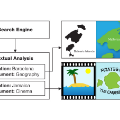Sampling from high-dimensional distributions is a fundamental problem in statistical research and practice. However, great challenges emerge when the target density function is unnormalized and contains isolated modes. We tackle this difficulty by fitting an invertible transformation mapping, called a transport map, between a reference probability measure and the target distribution, so that sampling from the target distribution can be achieved by pushing forward a reference sample through the transport map. We theoretically analyze the limitations of existing transport-based sampling methods using the Wasserstein gradient flow theory, and propose a new method called TemperFlow that addresses the multimodality issue. TemperFlow adaptively learns a sequence of tempered distributions to progressively approach the target distribution, and we prove that it overcomes the limitations of existing methods. Various experiments demonstrate the superior performance of this novel sampler compared to traditional methods, and we show its applications in modern deep learning tasks such as image generation. The programming code for the numerical experiments is available at https://github.com/yixuan/temperflow.
翻译:采样高维分布是统计研究和实践中的基本问题。然而,当目标密度函数是未正则化的,并包含孤立的模式时,就会产生巨大的挑战。我们通过拟合一个从参考概率分布到目标分布之间的可逆映射,即运输映射,来解决这个困难问题,从而可以通过将参考样本通过运输映射向前推进来从目标分布中进行采样。我们使用 Wasserstein 梯度流理论理论分析了现有运输基础采样方法的局限性,并提出了一个新的方法 TemperFlow 来处理多模态问题。TemperFlow 自适应地学习一系列 tempered 分布,以逐步接近目标分布,我们证明它克服了现有方法的限制。各种实验证明了这种新型采样器与传统方法相比具有优越的性能,我们展示了它在现代深度学习任务中如图像生成的应用。数值实验的程序代码可在 https://github.com/yixuan/temperflow 上获取。


